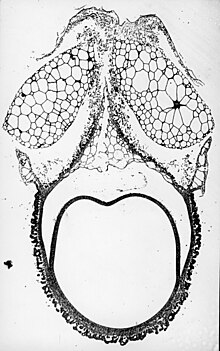 |
| Wolfgang Mackowiack, Univ Cologne, Germany Transmission Electron Micro of Azolla Megaspore. Wiki Commons |
OK enough flesh rippin' theropods and #dinomania#awesomebro- back to boring plants. And the plant I want to talk about today is little ol' Azolla a diminutive floating, aquatic fern. But don't let the dainty, petite structure of this fern fool you- this is a battle-tested, supercharged plant for the ages. And as you will see shortly some believe it helped reverse global warming.
Now I had heard a little about this fern before and given that I am interested in ferns, invasive species, and such it was with much interest that I came across a patch in a local drainage ditch in my neighborhood. As you can see from the pic below it is quite good at forming solid mats in still water.
 |
| Duane Nash |
 |
| Wiki. Azolla In Australia |
Rice paddies are often inoculated with Azolla to suppress weeds, limit mosquitos, and serve as a bio-fertilizer for the rice. The fern itself is exceptionally nutritious with proteins, essential amino acids, vitamins, and minerals. Experiments as food stock for cattle, ducks, chickens, and pigs have met with success although it should be mentioned that when under feeding stress the plant produces deoxyanthocyanins which lowers polyunsaturated fatty acids in the fronds and therefore palatability.
does not tolerate saltwater but as the pic of the Eocene arctic to the right shows the Arctic Ocean was largely cut off from other oceans, decreasing circulation and salinity like the Back Sea today. Some have theorized that with abundant river run-off and lack of circulation a lighter layer of freshwater existed on the surface of the Arctic Ocean permitting Azolla colonization. During the arctic summer this stagnant, warm body of water was ideal for Azolla. Being a super-charged super plant these huge mats of Azolla would soak up tonnes of carbon dioxide and when it died during the winter, would sink to the bottom and lock that carbon up. And in this manner Azolla is suggested to have stimulated a global cool down from the "Hothouse" conditions of the Eocene to more contemporary "Icebox" conditions. Others suggest that there was no such Azolla layer and seasonal storms simply swept rafts of Azolla out to sea. Given that the Arctic is of much interest to the oil industry there is actually much ongoing study into the Azolla event.
But back to dinosaurs really quick- we do have records of Azolla going back well into the early Cretaceous. It should not have escaped your notice that this nutritious, fast growing plant could have served as ideal forage for herbivorous dinos. It does require us to put dinos back into the swamps however, at least for part time.
Cheers!!!
Support me on Patreon.
Like antediluvian salad on facebook.
Watch me on Deviantart @NashD1.Subscribe to my youtube channel Duane Nash.
My other blog southlandbeaver.blogspot.


No comments:
Post a Comment